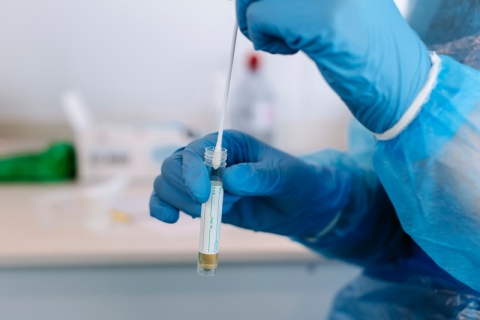

Results from studies investigating outbreaks at the University of Portsmouth and University of Glasgow are adding to the emerging picture of COVID-19 infections in higher education institutes
In January 2021, COG-UK reported preliminary results of SARS-CoV-2 sequencing studies in students from the University of Cambridge. Now, further results from studies investigating outbreaks at the University of Portsmouth (led by researchers there) and University of Glasgow (led by NHS Greater Glasgow and Clyde and Public Health Scotland) are adding to the emerging picture of COVID-19 infections in higher education institutes.
This month, we gathered together a group of COG-UK researchers to compare interim results from investigations at all three Universities: Glasgow, Cambridge and Portsmouth.
The three studies have similar aims: to use the sequencing capabilities of COG-UK to understand more about the introduction and transmission of SARS-CoV-2 within the student population and local communities. In particular, the researchers are hoping to learn about the risks posed to students by SARS-CoV-2, the origin of student infections (is the virus introduced from home or from communities local to the university?), the direction of spread between students and wider community (is there flow in both directions?), and how infections pass amongst the students themselves (where and when do transmission events occur?).
In all three universities, COVID-19 cases increased amongst students shortly after term began, with a number of outbreaks being identified. Following public health intervention, including the implementation of infection control measures such as increased testing, use of remote learning and self-isolation by students, the numbers of cases dropped. Subsequently, cases tended to remain low for the remainder of term, with the occasional emergence of small, relatively short-lived clusters.
In general, the outbreaks were observed to start from multiple introductions of the virus, with infections thought to originate from both students’ home residence communities and also the local communities in which the universities are found. Most outbreaks appeared to grow by student to student transmission of a subset of the initial infections, and so involving a relatively small number of distinct viruses overall. In Cambridge and Portsmouth, systematic testing allowed asymptomatic spread between students to be tracked and was found to play a role in outbreak growth.
There was some evidence consistent with onward transmission to local communities, although these indications were difficult to disentangle from any coincidental rise in community cases. Portsmouth in particular, found that infection rates amongst students were considerably lower than age-matched cases in the surrounding community.
At Cambridge, the largest cluster was examined in detail to understand how the spread had occurred. This cluster was found to include multiple colleges (which act both as accommodation and social hubs), multiple year groups and multiple courses. This is in contrast to smaller clusters which tended to have much less overlap across years, courses and colleges and so were easier to contain. Stratification by year of study showed that first year students were by far the most likely to contract and spread the virus, with students in higher years and postgraduates remaining less affected.
The investigation at Glasgow, led by the Health Protection Team at NHS Greater Glasgow and Clyde and Public Health Scotland in a collaboration with MRC-University of Glasgow Centre for Virus Research where sequencing was performed, presents an informative comparison. This outbreak was contained to off-campus accommodation, primarily student residential halls, highlighting the importance of considering the household, social, and academic context of the student population when assessing transmission risks and implementing control measures.
Data analysis is continuing, with results informing public health policy guidance. In the longer term, we hope to be able to further facilitate genomic data sharing and advance scientific understanding in order to contribute to the growing evidence-base around transmission risks and intervention effectiveness in the university setting.
As with all COG-UK research, the completed studies will be published and made available to the academic and public health communities.
COVID-19 Genomics UK (COG-UK)
The current COVID-19 pandemic, caused by SARS-CoV-2, represents a major threat to health. The COVID-19 Genomics UK (COG-UK) consortium has been created to deliver large-scale and rapid whole-genome virus sequencing to local NHS centres and the UK government.
Led by Professor Sharon Peacock of the University of Cambridge, COG-UK is made up of an innovative partnership of NHS organisations, the four Public Health Agencies of the UK, the Wellcome Sanger Institute and twelve academic partners providing sequencing and analysis capacity. A full list of collaborators can be found on the Covid-19 Genomics UK Consortium website. Professor Peacock is also on a part-time secondment to PHE as Director of Science, where she focuses on the development of pathogen sequencing through COG-UK.
COG-UK was established in April 2020 supported by £20 million funding from the COVID-19 rapid-research-response “fighting fund” from Her Majesty’s Treasury (established by Professor Chris Whitty and Sir Patrick Vallance), and administered by the National Institute for Health Research (NIHR), UK Research and Innovation (UKRI), and the Wellcome Sanger Institute. The consortium was also backed by the Department of Health and Social Care’s Testing Innovation Fund on 16 November 2020 to facilitate the genome sequencing capacity needed to meet the increasing number of COVID-19 cases in the UK over the winter period.
Dr Sam Robson is a Senior Research Fellow at the School of Pharmacy and Biomedical Sciences in the Faculty of Science and Health.
This article is republished from the COG-UK website under a Creative Commons Licence. Read the original article.
